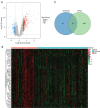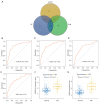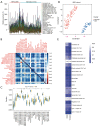Identification of key biomarkers and immune infiltration in renal interstitial fibrosis
- PMID: 35280428
- PMCID: PMC8908133
- DOI: 10.21037/atm-22-366
Identification of key biomarkers and immune infiltration in renal interstitial fibrosis
Abstract
Background: Renal interstitial fibrosis (RIF) is the common final pathway that mediates almost all progressive renal diseases. However, the underlying mechanisms of RIF have not been fully elucidated. Therefore, the current study aimed to explore the etiology of RIF and identify the key targets and immune infiltration patterns of RIF.
Methods: Ribonucleic acid (RNA)-seq data of RIF and normal samples were downloaded from the Gene Expression Omnibus (GEO) database. Weighted gene co-expression network analysis (WGCNA) was performed to screen relevant modules associated with RIF. Differentially expressed genes (DEGs) between the RIF and normal samples were identified using the limma package. Machine learning methods were used to identify hub gene signatures related to RIF. Further biochemical approaches including quantitative polymerase chain reaction (qPCR), immunoblotting and immunohistochemistry experiments were performed to verify the hub signatures in the RIF samples. Single sample gene set enrichment analysis (ssGSEA) was used to analyze the proportions of 28 immune cells in RIF and normal samples.
Results: WGCNA showed 121 RIF-related genes. A total of 523 DEGs were found between the RIF and normal samples. By overlapping these genes, we obtained 78 RIF-related genes, which were mainly enriched in Gene Ontology (GO) and Kyoto Encyclopedia of Genes and Genomes (KEGG) pathways associated with immunity and inflammation. Integrative analysis of machine learning methods showed prominin 1 (PROM1), tryptophan aspartate-containing coat protein (CORO1A), interferon-stimulated exonuclease gene 20 (ISG20), and tissue inhibitor matrix metalloproteinase 1 (TIMP1) as hub gene signatures in RIF. Further, receiver operating curve (ROC) curves implied the diagnostic role of ISG20 and CORO1A in RIF. The expression levels of ISG20 and CORO1A were significantly higher in fibrotic tubular cells and renal tissues based on biochemical approaches. The immune microenvironment was found to be markedly altered in the RIF samples, as 21 differentially infiltrated immune cells (DIICs) were found between RIF and normal samples.
Conclusions: This study is the first to find that ISG20 and CORO1A are key biomarkers and to examine the landscape of immune infiltration in RIF. Our findings provide novel insights into the mechanisms and treatment of patients with RIF.
Keywords: CORO1A; ISG20; Renal interstitial fibrosis (RIF); immune infiltration; machine learning.
2022 Annals of Translational Medicine. All rights reserved.
Conflict of interest statement
Conflicts of Interest: All authors have completed the ICMJE uniform disclosure form (available at https://atm.amegroups.com/article/view/10.21037/atm-22-366/coif). The authors have no conflicts of interest to declare.
Figures








Similar articles
-
WGCNA combined with machine learning algorithms for analyzing key genes and immune cell infiltration in heart failure due to ischemic cardiomyopathy.Front Cardiovasc Med. 2023 Mar 17;10:1058834. doi: 10.3389/fcvm.2023.1058834. eCollection 2023. Front Cardiovasc Med. 2023. PMID: 37008314 Free PMC article.
-
Identification of biomarkers and immune microenvironment associated with heart failure through bioinformatics and machine learning.Front Mol Biosci. 2025 May 8;12:1580880. doi: 10.3389/fmolb.2025.1580880. eCollection 2025. Front Mol Biosci. 2025. PMID: 40406620 Free PMC article.
-
Bioinformatics-Based Identification of Key Prognostic Genes in Neuroblastoma with a Focus on Immune Cell Infiltration and Diagnostic Potential of VGF.Pharmgenomics Pers Med. 2024 Oct 10;17:453-472. doi: 10.2147/PGPM.S461072. eCollection 2024. Pharmgenomics Pers Med. 2024. PMID: 39403102 Free PMC article.
-
Screening and identification of potential hub genes and immune cell infiltration in the synovial tissue of rheumatoid arthritis by bioinformatic approach.Heliyon. 2023 Jan 10;9(1):e12799. doi: 10.1016/j.heliyon.2023.e12799. eCollection 2023 Jan. Heliyon. 2023. PMID: 36699262 Free PMC article.
-
Identification and validation of HOXD3 and UNC5C as molecular signatures in keloid based on weighted gene co-expression network analysis.Genomics. 2022 Jul;114(4):110403. doi: 10.1016/j.ygeno.2022.110403. Epub 2022 Jun 13. Genomics. 2022. PMID: 35709926
Cited by
-
Comprehensive strategy for identifying extracellular vesicle surface proteins as biomarkers for chronic kidney disease.Front Physiol. 2024 Feb 6;15:1328362. doi: 10.3389/fphys.2024.1328362. eCollection 2024. Front Physiol. 2024. PMID: 38379702 Free PMC article. Review.
-
Targeting interferon-stimulated gene of 20 kDa protein (Isg20) inhibits ribosome biogenesis to ameliorate the progression of renal fibrosis.PLoS One. 2025 Jul 7;20(7):e0322639. doi: 10.1371/journal.pone.0322639. eCollection 2025. PLoS One. 2025. PMID: 40622935 Free PMC article.
-
Proteomic Fingerprint of Lung Fibrosis Progression and Response to Therapy in Bleomycin-Induced Mouse Model.Int J Mol Sci. 2023 Feb 23;24(5):4410. doi: 10.3390/ijms24054410. Int J Mol Sci. 2023. PMID: 36901840 Free PMC article.
-
Activation of sclerostin inhibits Isg20-Mediated aerobic glycolysis ameliorating renal Fibrosis: the renoprotective mechanism of hederagenin in CKD.Redox Biol. 2025 Jul 8;85:103762. doi: 10.1016/j.redox.2025.103762. Online ahead of print. Redox Biol. 2025. PMID: 40644925 Free PMC article.
-
Integrated bioinformatical analysis, machine learning and in vitro experiment-identified m6A subtype, and predictive drug target signatures for diagnosing renal fibrosis.Front Pharmacol. 2022 Aug 31;13:909784. doi: 10.3389/fphar.2022.909784. eCollection 2022. Front Pharmacol. 2022. PMID: 36120336 Free PMC article.
References
LinkOut - more resources
Full Text Sources
Research Materials
Miscellaneous
